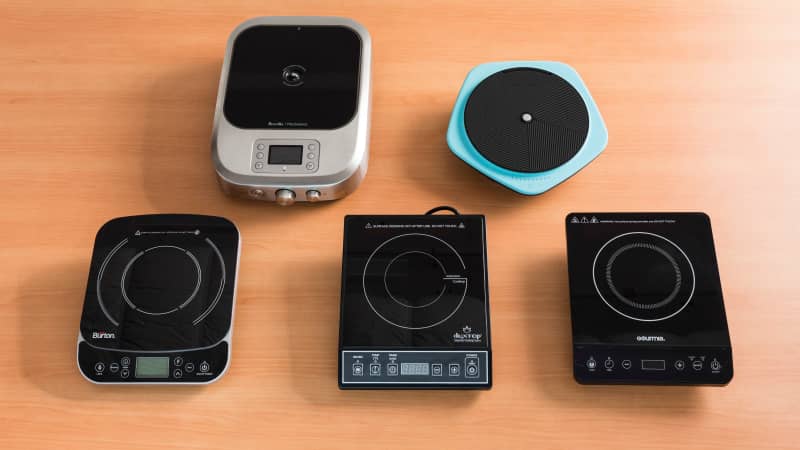Induction Interface Disks
Equipment Review
An extra burner may be useful during the holidays, but can it do enough to justify a place in your kitchen?
Last Updated Feb. 23, 2023.

Max Burton, the manufacturer of our co-winner, recently stopped making induction burners. We surveyed the market, hoping to find a new induction burner that performs comparably. We still think the Breville/PolyScience Control Freak is the best portable induction burner on the market, but if you’d like to try a more reasonably priced entry-level burner, we recommend the Duxtop Portable Induction Cooktop 9600LS/BT-200DZ. It’s easy to operate, boils water quickly, and does a mostly good job of maintaining accurate temperatures. However, because its heating coil is smaller than the Breville’s, we recommend using it with slightly smaller cookware to match. Want to learn how to get the most out of your induction burner? See our article here.
Induction cooking uses magnetism to generate heat and cook your food. This may sound a bit more high-tech than your standard gas stove, but induction cooking is massively popular in Japan and Europe. In fact, induction cooktops accounted for 54 percent of stoves sold in western Europe in 2016, according to Allied Market Research, a global market research firm.
Why induction? Induction burners are known to heat up very quickly and hold a consistent temperature and are purportedly safer, since they are flameless and often have features such as automatic shut-off and screen-locking mechanisms. They are also easier to clean and are more energy-efficient than gas or electric stovetops.
Although induction cooktops aren’t quite as widespread in the United States just yet, portable induction burners are a common option for cooks looking for a bit more burner space or for those with small kitchens that aren’t equipped with large stoves. Since we last tested induction burners, new models such as the Tasty One Top and the Breville/PolyScience Control Freak have come onto the market, with features such as built-in temperature probes that claim to dial in ultraprecise temperatures. Are induction burners the new “must-have” kitchen gadget?
To find out which induction burner is best, we selected a wide variety of models, using each to boil water, sear burgers, make All-Purpose Caramel Sauce, deep-fry Fried Zucchini Sticks, and keep Cheese Fondue warm for 4 hours.
An induction burner contains an electric coil that produces a magnetic field when it’s turned on. When a pan with a ferromagnetic bottom is placed on the burner, the energy from the magnetic field causes the material of the pan to produce heat. The induction burner won’t actually turn on unless there’s a compatible pan.
Since only the metal of the pan heats up, all the energy goes directly into the cookware, whereas with electric or gas stovetops, some of that energy spills over, heating the air and the surrounding stove area. This is one reason that induction burners are known as being more energy efficient than electric stovetops (and why they keep your kitchen cooler).
We began with the basics: boiling and simmering water. On each induction burner, we boiled 4 quarts of water and then reduced it to a simmer, timing how long the water took to boil and noting how responsive the burners were to changes in temperature by timing how long it took the water to return to a simmer. We compared the results with those of the same test done on gas and electric stovetops.
The conventional wisdom is ...

The mission of America’s Test Kitchen Reviews is to find the best equipment and ingredients for the home cook through rigorous, hands-on testing. We stand behind our winners so much that we even put our seal of approval on them.

Valerie is an associate editor for ATK Reviews. In addition to cooking, she loves skiing, traveling, and spending time outdoors.

This is a members' feature.